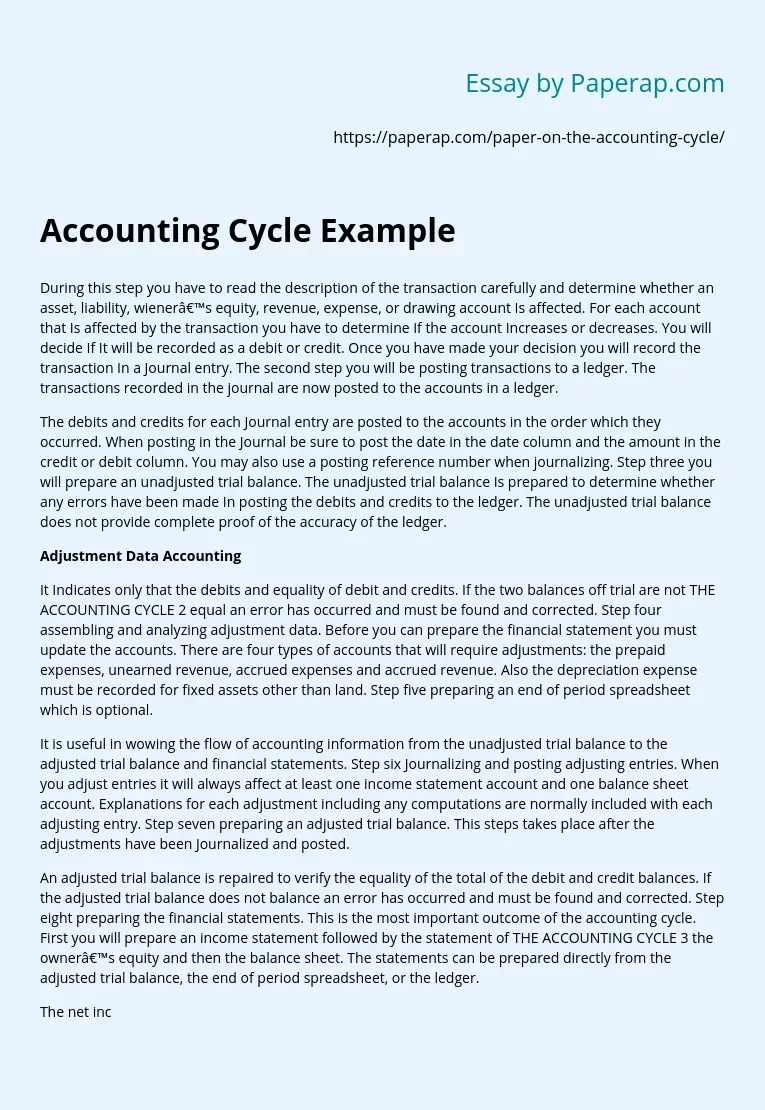Accounting Cycle Example
During this step you have to read the description of the transaction carefully and determine whether an asset, liability, wiener’s equity, revenue, expense, or drawing account Is affected. For each account that Is affected by the transaction you have to determine If the account Increases or decreases. You will decide If It will be recorded as a debit or credit. Once you have made your decision you will record the transaction In a Journal entry. The second step you will be posting transactions to a ledger.
The transactions recorded in the journal are now posted to the accounts in a ledger.
The debits and credits for each Journal entry are posted to the accounts in the order which they occurred. When posting in the Journal be sure to post the date in the date column and the amount in the credit or debit column. You may also use a posting reference number when journalizing. Step three you will prepare an unadjusted trial balance.
The unadjusted trial balance Is prepared to determine whether any errors have been made In posting the debits and credits to the ledger. The unadjusted trial balance does not provide complete proof of the accuracy of the ledger.
Adjustment Data Accounting
It Indicates only that the debits and equality of debit and credits. If the two balances off trial are not THE ACCOUNTING CYCLE 2 equal an error has occurred and must be found and corrected. Step four assembling and analyzing adjustment data. Before you can prepare the financial statement you must update the accounts.
There are four types of accounts that will require adjustments: the prepaid expenses, unearned revenue, accrued expenses and accrued revenue. Also the depreciation expense must be recorded for fixed assets other than land. Step five preparing an end of period spreadsheet which is optional.
It is useful in wowing the flow of accounting information from the unadjusted trial balance to the adjusted trial balance and financial statements. Step six Journalizing and posting adjusting entries. When you adjust entries it will always affect at least one income statement account and one balance sheet account. Explanations for each adjustment including any computations are normally included with each adjusting entry. Step seven preparing an adjusted trial balance. This steps takes place after the adjustments have been Journalized and posted.
An adjusted trial balance is repaired to verify the equality of the total of the debit and credit balances. If the adjusted trial balance does not balance an error has occurred and must be found and corrected. Step eight preparing the financial statements. This is the most important outcome of the accounting cycle. First you will prepare an income statement followed by the statement of THE ACCOUNTING CYCLE 3 the owner’s equity and then the balance sheet. The statements can be prepared directly from the adjusted trial balance, the end of period spreadsheet, or the ledger.
The net income or net loss shown on the income statement is reported on the statement of owner’s equity along with any additional investments by the owner and any withdrawals. The ending owner’s capital is then reported on the balance sheet and is added with total liabilities to equal total assets. Step nine Journalizing and posting closing entries. At the end of each accounting period the four closing entries are required. 1. Debit each revenue account for its balance and credit income summary for the total revenue. 2.
Credit each expense account for its balance and debit income marry for the total expenses. 3. Debit income summary for its balance and credit the owner’s capital account. 4. Debit the owner’s capital account for the balance of the drawing and credit the drawing account. Prepared after the closing entries have been posted. The purpose of the post- closing trial balance is to verify that the ledger is in balance at the beginning of the next period. The accounts and amounts in the post-closing trial balance should agree exactly with the accounts and amounts listed on the balance sheet at end of the period.
Accounting Cycle Example. (2019, Dec 05). Retrieved from https://paperap.com/paper-on-the-accounting-cycle/

